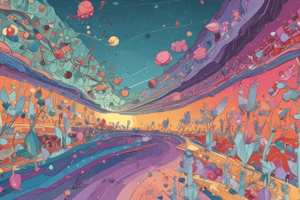Podcast
Questions and Answers
Where are H1 receptors primarily found?
Where are H1 receptors primarily found?
- Stomach
- Lungs
- Smooth muscle, endothelium, and nervous system (correct)
- Liver
Histamine is responsible for increasing blood pressure.
Histamine is responsible for increasing blood pressure.
True (A)
What are the main objectives of the session on antihistamines?
What are the main objectives of the session on antihistamines?
understand antihistamines, their functions in the body, and their effects
Histamine is synthesized by __________ cells.
Histamine is synthesized by __________ cells.
Match the following examples with their correct type of antihistamines:
Match the following examples with their correct type of antihistamines:
¿Cuál es el objetivo de la sesión sobre antihistamínicos con Jumper Arias?
¿Cuál es el objetivo de la sesión sobre antihistamínicos con Jumper Arias?
La histamina se forma por la descarbonización del aminoácido histidina.
La histamina se forma por la descarbonización del aminoácido histidina.
¿Qué función desempeña la histamina en la vasodilatación de las arteriolas?, disminuyendo la presión arterial.
¿Qué función desempeña la histamina en la vasodilatación de las arteriolas?, disminuyendo la presión arterial.
¿Cuál es la principal diferencia entre los antihistamínicos H1 de primera y segunda generación?
¿Cuál es la principal diferencia entre los antihistamínicos H1 de primera y segunda generación?
¿Qué receptores bloquean los antihistamínicos H2 en el estómago?
¿Qué receptores bloquean los antihistamínicos H2 en el estómago?
Flashcards are hidden until you start studying
Study Notes
Introduction to Antihistamines
- Presenter introduces himself as Jumper Arias, a member of the Peruvian University Cayetano Heredia's Clinical Intelligence Society
- Main objectives of the session: understand antihistamines, their functions in the body, and their effects
Histamine: Definition and Functions
- Histamine: a chemical compound produced by the body, synthesized by mast cells
- Functions:
- Stimulates nerve endings, causing pain and itching
- Regulates sleep-wake cycle
- Involved in appetite control
- Modulates neurotransmitter release
- Vasodilates blood vessels, decreasing blood pressure
- Increases heart rate
- Constricts smooth muscle, causing bronchoconstriction
Histamine Receptors
- H1 receptors: found in smooth muscle, endothelium, and nervous system
- H2 receptors: found in stomach, responsible for gastric acid secretion
Anaphylaxis
- A severe allergic reaction caused by histamine release
- Symptoms: skin rash, itching, swelling, nausea, vomiting, diarrhea, abdominal cramps, rapid heartbeat, and fall in blood pressure
- Triggers: food, insect bites, medications, latex, and other allergens
Antihistamines
- Classification:
- H1 antihistamines:
- 1st generation: crosses blood-brain barrier, causing sedation
- 2nd generation: does not cross blood-brain barrier, non-sedating
- H2 antihistamines: blocks H2 receptors in stomach, reducing gastric acid secretion
- H1 antihistamines:
H1 Antihistamines
- Uses:
- Allergic reactions (rash, itching, hives)
- Insect bites
- Motion sickness
- Insomnia
- Examples of H1 antihistamines:
- 1st generation: chlorpheniramine, diphenhydramine
- 2nd generation: loratadine, cetirizine
H2 Antihistamines
- Uses:
- Gastroesophageal reflux disease (GERD)
- Peptic ulcers
- Zollinger-Ellison syndrome
- Examples of H2 antihistamines:
- Ranitidine, cimetidine, nizatidine, famotidine
Pharmacokinetics and Pharmacodynamics
- H1 antihistamines:
- Well-absorbed orally
- Metabolized by the liver
- Excreted by the kidneys
- H2 antihistamines:
- Well-absorbed orally
- Metabolized by the liver
- Excreted by the kidneys and liver
Introduction to Antihistamines
- Jumper Arias, a member of the Peruvian University Cayetano Heredia's Clinical Intelligence Society, leads the session on antihistamines
- The session aims to understand antihistamines, their functions in the body, and their effects
Histamine: Definition and Functions
- Histamine is a chemical compound produced by the body, synthesized by mast cells
- Histamine stimulates nerve endings, causing pain and itching
- It regulates sleep-wake cycle, appetite control, and modulates neurotransmitter release
- It vasodilates blood vessels, decreasing blood pressure, and increases heart rate
- Additionally, it constricts smooth muscle, causing bronchoconstriction
Histamine Receptors
- H1 receptors are found in smooth muscle, endothelium, and nervous system
- H2 receptors are found in the stomach, responsible for gastric acid secretion
Anaphylaxis
- Anaphylaxis is a severe allergic reaction caused by histamine release
- Symptoms include skin rash, itching, swelling, nausea, vomiting, diarrhea, abdominal cramps, rapid heartbeat, and fall in blood pressure
- Triggers include food, insect bites, medications, latex, and other allergens
Antihistamines
- Antihistamines can be classified into H1 and H2 antihistamines
- H1 antihistamines can be further divided into 1st generation (crosses blood-brain barrier, causing sedation) and 2nd generation (does not cross blood-brain barrier, non-sedating)
- H2 antihistamines block H2 receptors in the stomach, reducing gastric acid secretion
H1 Antihistamines
- H1 antihistamines are used to treat allergic reactions (rash, itching, hives), insect bites, motion sickness, and insomnia
- Examples of H1 antihistamines include 1st generation (chlorpheniramine, diphenhydramine) and 2nd generation (loratadine, cetirizine)
H2 Antihistamines
- H2 antihistamines are used to treat gastroesophageal reflux disease (GERD), peptic ulcers, and Zollinger-Ellison syndrome
- Examples of H2 antihistamines include ranitidine, cimetidine, nizatidine, and famotidine
Pharmacokinetics and Pharmacodynamics
- H1 antihistamines are well-absorbed orally, metabolized by the liver, and excreted by the kidneys
- H2 antihistamines are well-absorbed orally, metabolized by the liver, and excreted by the kidneys and liver
Introduction to Antihistamines
- The session aims to understand antihistamine medications, their functions in the body, side effects, and resolution of clinical context questions.
Histamine
- Histamine is a chemical compound produced by the body, synthesized mainly by mast cells.
- Mast cells are part of the immune system, mediating allergic and inflammatory responses.
- Histamine is found in tissues such as lungs, skin, blood vessels, and gastrointestinal tract.
- Histamine is formed by decarboxylation of the amino acid histidine.
Functions of Histamine
- Stimulates sensory nerve endings, mediating pain and itch perception.
- Regulates sleep-wake cycle.
- Modulates appetite and satiety.
- Regulates neurotransmitter release in the nervous system.
- Causes vasodilation of arterioles, decreasing blood pressure.
- Increases heart rate.
- Regulates smooth muscle contraction in internal organs.
- Stimulates gastric secretion.
Anaphylaxis
- An allergic reaction that induces histamine release.
- Causes: food allergy, insect bites, medication reactions, etc.
- Symptoms: erythema, urticaria, edema, hypotension, respiratory distress, tachycardia, nasal congestion.
H1 Antihistamines
- Divided into two groups: first and second generation.
- First-generation antihistamines cross the blood-brain barrier, causing sedation and somnolence.
- Second-generation antihistamines do not cross the blood-brain barrier, without sedation and somnolence.
- Clinical uses: treatment of allergies, insomnia, nausea, and vomiting.
H2 Antihistamines
- Block H2 receptors in stomach parietal cells, decreasing gastric acid secretion.
- Clinical uses: treatment of peptic ulcers, gastroesophageal reflux, gastritis, Zollinger-Ellison syndrome.
Pharmacokinetics of Antihistamines
- Well-absorbed orally, reaching maximum plasma concentration in 1-2 hours.
- First-generation antihistamines have a half-life of 4-6 hours, while second-generation antihistamines have a half-life of 12-24 hours.
- Metabolized in the liver and excreted in urine and feces.
Studying That Suits You
Use AI to generate personalized quizzes and flashcards to suit your learning preferences.




